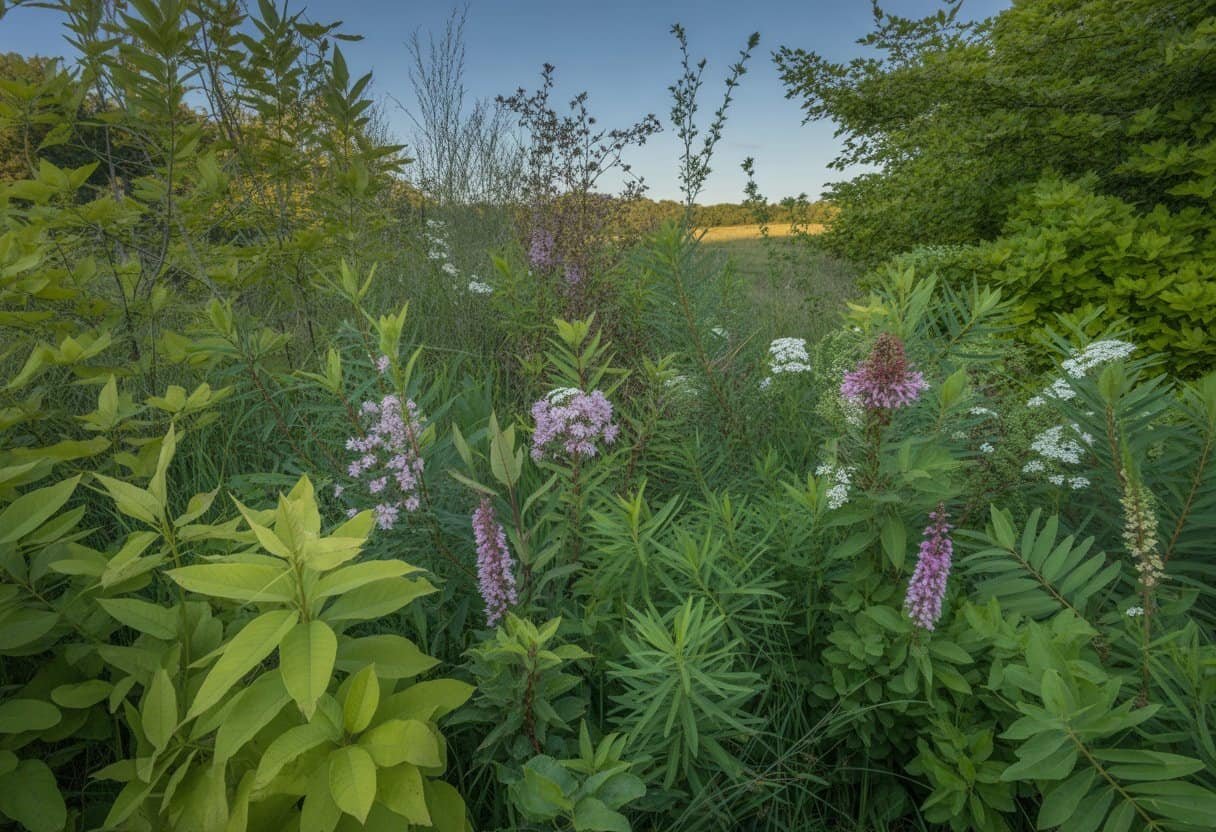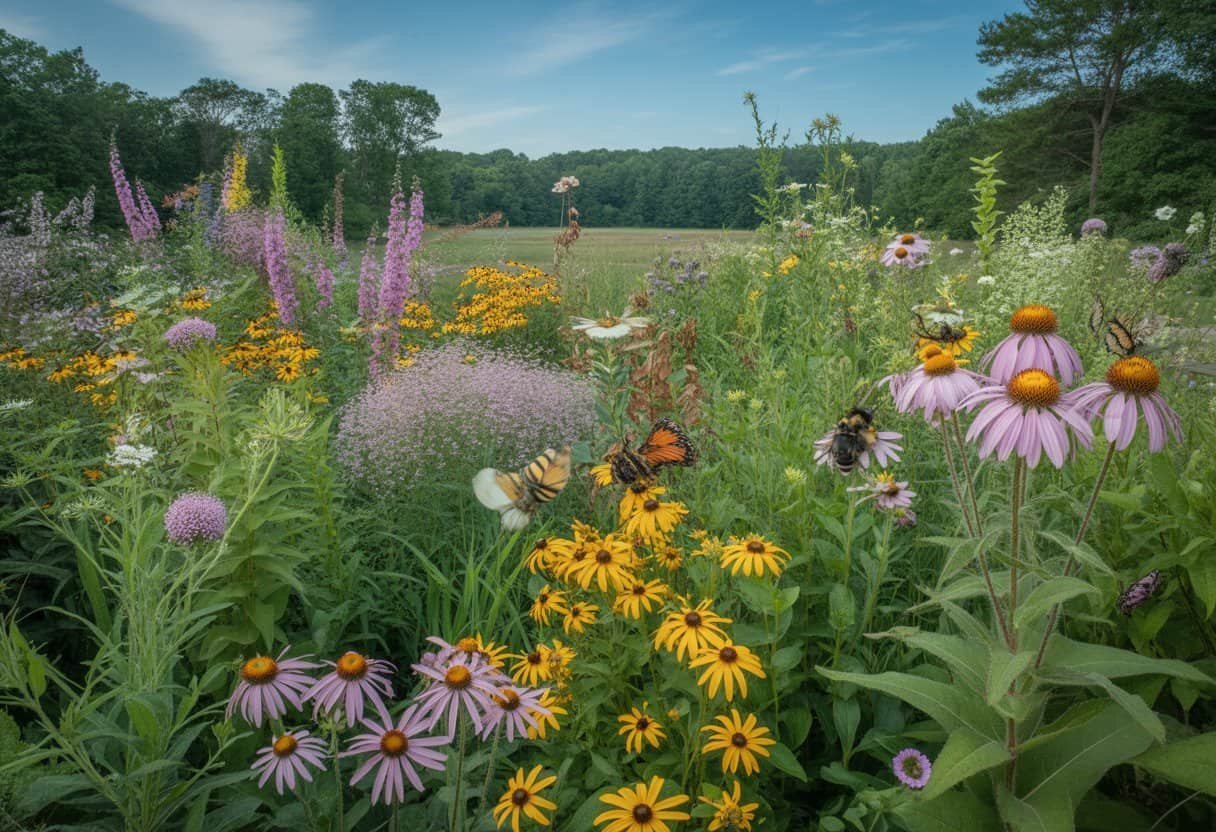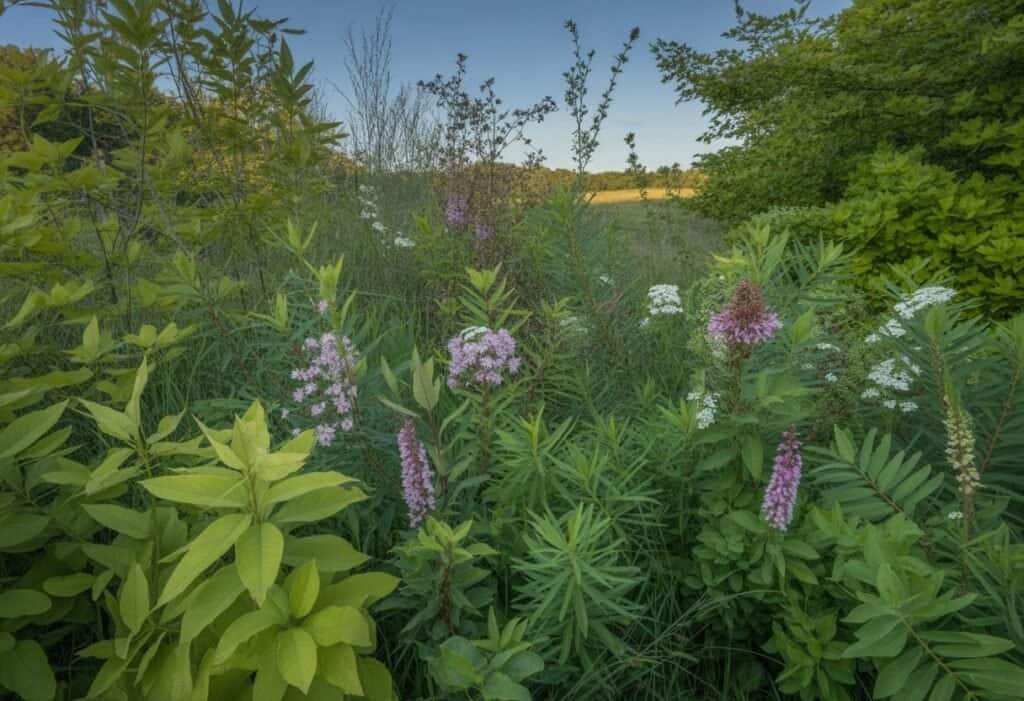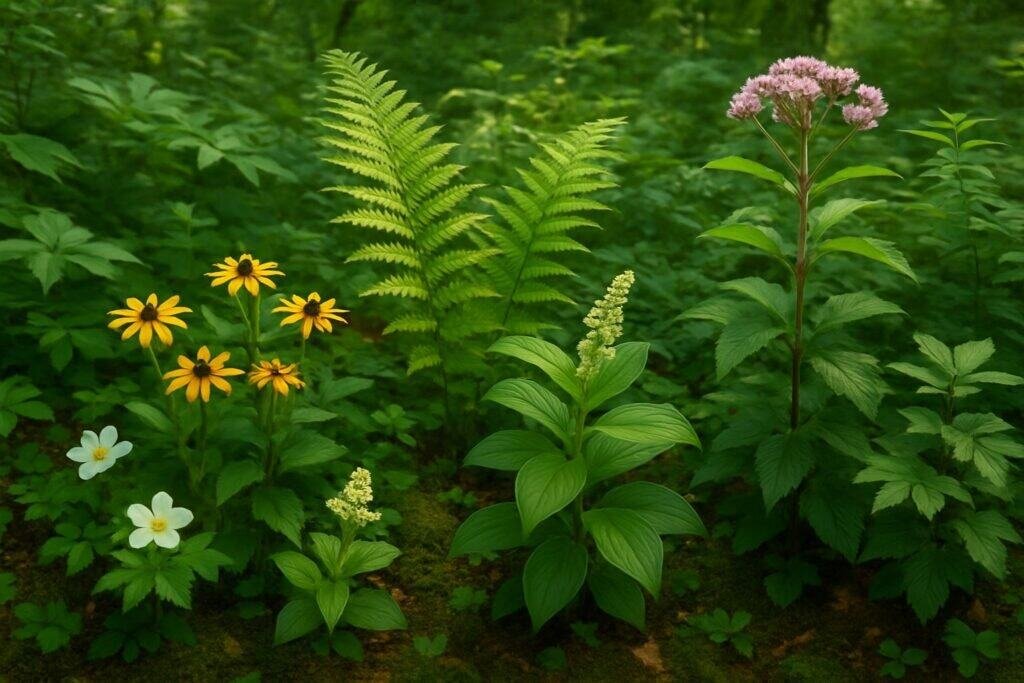Native plants in Connecticut offer a beautiful way to enhance your garden while supporting local wildlife and ecosystems. These plants have evolved in our region over thousands of years, developing special relationships with local insects, birds, and other wildlife.
Choosing native plants for your Connecticut garden helps conserve water, reduce maintenance needs, and create vital habitat for pollinators and other beneficial creatures.

Connecticut’s diverse landscape supports a rich variety of native plants, from woodland wildflowers to coastal grasses. Many homeowners are discovering that native plants thrive with minimal care and bring seasonal interest and natural beauty to their yards.
You can find native plants that work well in any garden setting. Whether you have a sunny meadow, shady woodland, or something in between, there are native options for you.
Key Takeaways
- Native Connecticut plants require less water, fertilizer, and maintenance while supporting local wildlife populations.
- Popular native options include mountain laurel, New England aster, and eastern redbud that provide year-round visual interest.
- Adding native plants to your garden helps protect Connecticut’s biodiversity and ecological health for future generations.
Understanding Native Plants in Connecticut
Connecticut’s landscape is home to a rich variety of native plants that have evolved in this region for thousands of years. These plants play crucial roles in supporting local wildlife, preserving biodiversity, and maintaining healthy ecosystems throughout the state.
What Defines a Native Plant
Native plants are species that occurred naturally in Connecticut before European settlement. These plants adapted to local soil conditions, rainfall patterns, and seasonal changes over thousands of years.
Connecticut’s native flora includes trees like the Eastern White Pine and Red Maple. Shrubs such as Winterberry and Mountain Laurel (the state flower) and wildflowers like Black-eyed Susan and New England Aster also belong to this group.
Native plants share deep ecological relationships with local wildlife. They provide essential food and habitat for native insects, birds, and mammals.
Connecticut’s indigenous plants rarely become invasive. Natural predators and environmental factors keep their growth in check.
Benefits of Native Species
Native plants need little maintenance once established. They require minimal watering, fertilizer, or pesticides compared to non-native ornamentals.
These plants manage stormwater effectively, prevent erosion, and filter pollutants before they reach waterways. Their deep root systems improve soil structure and water absorption.
Wildlife Support: Native plant species provide critical food sources for pollinators and habitat for birds. For example, Oak trees support over 500 species of caterpillars that feed birds and other wildlife.
Using Connecticut native plants in landscapes helps preserve the state’s natural heritage and unique ecological identity.
Connecticut’s Unique Ecosystems
Connecticut contains several distinct ecosystems, each supporting specialized native plant communities. These range from coastal marshes to upland forests.
Coastal Areas: Salt-tolerant plants like Beach Plum and American Beach Grass thrive along Connecticut’s Long Island Sound shoreline. They stabilize dunes and provide habitat.
Wetlands throughout the state support moisture-loving natives such as Swamp Milkweed and Cardinal Flower. These areas serve as natural water filters and wildlife nurseries.
Connecticut’s woodland understory features spring ephemerals like Trillium and Bloodroot. These wildflowers bloom before trees leaf out, capturing early-season sunlight.
The state’s meadow ecosystems showcase grasses like Little Bluestem and colorful perennials that support many butterfly and bee species.
Popular Connecticut Native Plants

Connecticut’s landscape is home to a diverse array of native plants that thrive in the region’s climate and soil conditions. These native species provide important habitat for local wildlife while requiring less maintenance than non-native alternatives.
Native Wildflowers
New England Aster (Symphyotrichum novae-angliae) stands out with its vibrant purple blooms that appear in late summer through fall. This pollinator-friendly plant attracts many butterflies and bees.
Cardinal Flower (Lobelia cardinalis) features striking red blooms that hummingbirds love. It grows well in moist areas and can reach 3-4 feet tall.
Butterfly Weed (Asclepias tuberosa) produces bright orange flowers that serve as crucial monarch butterfly habitat. It prefers drier soil conditions.
Wild Columbine (Aquilegia canadensis) displays distinctive red and yellow nodding flowers in spring. This adaptable plant grows in both sun and partial shade.
Other notable Connecticut wildflowers include:
- Foamflower (Tiarella cordifolia) – delicate white flowers
- Wild Ginger (Asarum canadense) – unique ground-level blooms
- Boneset (Eupatorium perfoliatum) – clusters of white flowers
- Marsh Marigold (Caltha palustris) – bright yellow blooms in wet areas
Native Trees
Red Maple (Acer rubrum) offers spectacular fall color and adapts to various soil conditions. It’s one of the first trees to flower in spring with tiny red blooms.
White Oak (Quercus alba) stands as a majestic, long-lived tree reaching heights of 80-100 feet. Its acorns provide vital food for wildlife.
Black Birch (Betula lenta) features aromatic twigs with a wintergreen scent when broken. Its exfoliating bark adds winter interest to the landscape.
American Beech (Fagus grandifolia) displays smooth gray bark and golden fall foliage. It creates dense shade, making it perfect for larger properties.
Other valuable native Connecticut trees include:
- Eastern Redbud (Cercis canadensis) – pink spring flowers
- Black Tupelo (Nyssa sylvatica) – brilliant red fall color
- Northern Red Oak (Quercus rubra) – fast-growing shade tree
- Eastern Hemlock (Tsuga canadensis) – evergreen for shade
Native Shrubs
Mountain Laurel (Kalmia latifolia), Connecticut’s state flower, produces clusters of pink to white blooms in late spring. This evergreen shrub thrives in woodland settings.
Winterberry (Ilex verticillata) offers bright red berries that persist through winter. This deciduous holly provides important winter food for birds.
Sweet Pepperbush (Clethra alnifolia) features fragrant white flower spikes in summer. It attracts many pollinators and tolerates wet conditions.
Red Chokeberry (Aronia arbutifolia) produces white spring flowers followed by red berries. Its fall foliage turns brilliant red, adding seasonal interest.
Other beneficial native shrubs include:
- Swamp Azalea (Rhododendron viscosum) – fragrant white flowers
- Smooth Sumac (Rhus glabra) – dramatic fall color
- Bearberry (Arctostaphylos uva-ursi) – evergreen groundcover
- Hawthorn (Crataegus species) – spring flowers and fall berries
Ground Covers and Ferns
Foamflower (Tiarella cordifolia) creates a low-growing carpet with delicate white flowers in spring. It spreads slowly to form an attractive groundcover in shady areas.
Wild Ginger (Asarum canadense) features unique heart-shaped leaves that form a dense mat. Its unusual flowers appear at ground level beneath the foliage.
Christmas Fern (Polystichum acrostichoides) remains evergreen through winter. Its leathery fronds add structure to woodland gardens year-round.
Ostrich Fern (Matteuccia struthiopteris) produces dramatic, vase-shaped growth up to 5 feet tall. Its fiddleheads emerge in spring as distinctive coiled fronds.
Other effective native ground covers include:
- White Wood Aster (Eurybia divaricata) – white flowers in shade
- Little Bluestem (Schizachyrium scoparium) – ornamental grass
- Narrow-leaf Mountain Mint (Pycnanthemum tenuifolium) – pollinator magnet
- Marginal Wood Fern (Dryopteris marginalis) – adaptable to rocky areas
Ecological Benefits of Native Plants

Native Connecticut plants provide essential support for local ecosystems while requiring less maintenance than non-native species. They have evolved alongside local wildlife, creating natural relationships that benefit the entire environment.
Supporting Biodiversity
Native plants form the foundation of Connecticut’s ecological communities. These plants evolved with local insects, birds, and other wildlife, creating interdependent relationships.
Studies show that native oak trees support over 500 species of caterpillars, while non-native ginkgo trees might support only a few. This difference dramatically impacts food availability for birds and other wildlife.
Connecticut’s native plants like mountain laurel, New England aster, and eastern redbud create diverse ecosystems that support many life forms. When multiple native species grow together, they create microhabitats that increase overall biodiversity.
Replacing exotic plants with natives can increase insect and bird species richness by 50% or more in suburban landscapes.
Pollinator Attraction
Native plants excel at attracting and supporting local pollinators. Connecticut’s native bees, butterflies, and other insects recognize these plants and depend on them for survival.
Plants like Joe-Pye weed, goldenrod, and cardinal flower provide essential nectar sources for honeybees, native bees, and butterflies. Their flower shapes and colors evolved specifically to attract Connecticut’s pollinators.
Hummingbirds strongly prefer native plants like trumpet honeysuckle and bee balm. These plants provide the high-energy nectar they need.
Native flowering plants bloom throughout different seasons, creating a continuous food supply for pollinators:
| Season | Native Plants for Pollinators |
|---|---|
| Spring | Wild geranium, columbine, lupine |
| Summer | Milkweed, coneflower, bergamot |
| Fall | Aster, goldenrod, sunflower |
Wildlife Habitat Enhancement
Native plants provide essential food, shelter, and nesting sites for Connecticut wildlife. Birds, mammals, and insects rely on these plants throughout their life cycles.
Berry-producing natives like winterberry holly and elderberry offer critical food sources when animals need them most. These fruits contain the nutrition local wildlife has adapted to consume.
Dense shrubs like arrowwood viburnum create protective cover for rabbits, songbirds, and other small animals. The branching patterns of native plants often match the nesting needs of local birds better than exotic species.
Native grasses and wildflowers in meadow settings support grassland birds. These plants provide both nesting material and hiding places.
Soil Health and Erosion Control
Native plant root systems strengthen Connecticut’s soils while preventing erosion. Many develop extensive underground networks adapted to local soil conditions.
Some native grasses extend roots 8-15 feet deep, far exceeding typical lawn grass. This depth improves soil structure by creating channels for water and air movement.
Plants like switchgrass and little bluestem stabilize slopes and prevent soil loss during heavy rains. Their dense growth pattern slows water runoff, allowing it to soak into the ground instead.
Native plants increase organic matter in soil as leaves and roots decompose. This improves soil fertility without chemical fertilizers and enhances the soil’s capacity to store carbon.
Connecticut’s wetland natives like swamp milkweed and cardinal flower filter pollutants from water. Their roots prevent shoreline erosion along ponds and streams.
Native Plant Gardening and Landscaping
Using Connecticut’s native plants in your garden creates beautiful spaces that support local wildlife while reducing maintenance needs. Native plants have adapted to local conditions over thousands of years, making them ideal choices for sustainable, eco-friendly landscapes.
Sustainable Landscaping Techniques
Native plants need less water once established. This reduces irrigation needs in Connecticut gardens.
They typically require fewer fertilizers and pesticides. Native plants thrive in local soil and resist regional pests.
Create buffer zones of native plants around water features to filter runoff. These zones also prevent erosion, especially in coastal areas and near streams.
Leave fallen leaves in garden beds when possible. They provide natural mulch and habitat for beneficial insects.
Group plants with similar water needs together to maximize efficiency. This strategy, called hydrozoning, conserves water and ensures plants receive the right moisture.
Replace portions of lawn with native meadow plants. These meadows need less mowing and provide habitat for pollinators and birds.
Design Principles for Native Gardens
Plan gardens with a mix of trees, shrubs, and perennials that flower at different times. Connecticut natives like dogwoods, viburnums, and asters offer seasonal color and texture.
Create layers in your landscape by mimicking natural forest structure. Use canopy trees, understory shrubs, and groundcovers to maximize habitat and visual interest.
Think in terms of plant communities rather than individual specimens. Plants that naturally grow together support each other and make gardens more resilient.
Add paths and seating areas to enjoy your native landscape up close. Natural materials like local stone blend well with native plantings.
Native plants can fit formal designs with careful pruning and placement. You are not limited to a “wild” look.
Incorporating Native Perennials
Connecticut’s native perennials provide reliable beauty with little maintenance. Black-eyed Susans, New England asters, and bee balm add bright colors and support pollinators.
Plant in drifts of 3-5 for greater visual impact and better wildlife support. This creates a more natural-looking garden than using single specimens.
Consider bloom times when selecting natives. Early spring plants like bloodroot and Virginia bluebells can be followed by summer coneflowers and fall asters for continuous color.
Native grasses and sedges, like little bluestem and Pennsylvania sedge, add texture and movement. They also provide winter interest and shelter for beneficial insects.
Native ferns thrive in Connecticut’s shady spots. Christmas fern, maidenhair fern, and ostrich fern add elegant texture to woodland gardens with minimal care.
Selecting and Planting Native Species
Connecticut’s landscape supports many beautiful native plants. Choosing the right plants and preparing your site properly helps your native garden thrive.
Choosing Plants for Sun and Shade
Consider your site’s light conditions first when selecting native plants. Full-sun areas (6+ hours of direct sunlight) support butterfly weed, black-eyed Susan, and little bluestem grass.
These sun-loving species attract pollinators and add vibrant colors. For partial shade (3-6 hours of sun), plant wild geranium, woodland phlox, or Solomon’s seal.
The Connecticut Botanical Society recommends these adaptable species for transitional garden areas. Deep shade areas benefit from native ferns, wild ginger, and woodland sedges.
Native Plant Trust maintains lists of shade-tolerant species adapted to Connecticut’s forests. Match plants to your site conditions for healthier plants and fewer maintenance issues.
Soil and Site Preparation
Connecticut soils range from sandy coastal areas to clay-rich inland regions. Test your soil before planting to determine pH and nutrients.
Most native plants prefer soil with pH between 5.5 and 7.0. Remove existing weeds and invasive plants completely before planting.
This reduces competition for your new native plants. Till only as needed since excessive disturbance brings dormant weed seeds to the surface.
Add a thin layer (1-2 inches) of compost to improve soil structure and fertility. Many natives thrive in lean soils and do not need extra amendments.
Mark planting areas with stakes or string to visualize the final layout before digging. This helps with proper spacing between plants.
Planting and Maintenance Best Practices
Plant Connecticut natives in spring or fall. Fall planting (September-October) gives roots time to establish before summer heat.
Dig holes twice as wide as the plant’s root ball but only as deep as the container. Native planting stock from local nurseries establishes faster than plants from distant regions.
Water thoroughly after planting. Most natives need regular watering during the first growing season but become drought-tolerant once established.
Apply 2-3 inches of mulch around plants, keeping it away from stems. Shredded leaves work well and mimic natural forest conditions.
Avoid fertilizers for most native plantings. These plants evolved to thrive without extra nutrients and may become weak if over-fertilized.
Remove invasive competitors regularly during the first few years. This helps your native garden establish successfully.
Challenges and Conservation Efforts
Connecticut’s native plant species face significant threats. Habitat loss, climate change, and competition from non-native species impact their survival.
Invasive Plants and Non-Native Threats
Invasive plants challenge Connecticut’s native flora. Species like Japanese Barberry, Oriental Bittersweet, and Purple Loosestrife outcompete native plants for resources.
These invaders can form dense monocultures that reduce biodiversity and alter ecosystems. The Connecticut Invasive Plant Working Group (CIPWG) identifies over 97 invasive species in the state.
Many of these plants were introduced as ornamentals. Non-native plants often lack natural predators and diseases, allowing them to spread rapidly.
Common invasive plants in Connecticut:
- Japanese Knotweed
- Multiflora Rose
- Garlic Mustard
- Norway Maple
- Autumn Olive
Conservation Initiatives
Multiple organizations protect Connecticut’s native plant heritage. The Connecticut Botanical Society conducts plant surveys and educates the public about native species.
CIPWG coordinates efforts to manage invasive plants through research, education, and early detection. Their biennial symposium brings together experts and citizens.
The New England Wild Flower Society maintains seed banks of rare native plants. They also restore habitats with native plantings.
State laws prohibit the sale and transport of certain invasive species. Nurseries now offer native plant alternatives that provide ecological benefits.
Protecting Native Habitats
Preserving natural areas remains essential for native plant conservation. The Connecticut Department of Energy and Environmental Protection manages state forests and natural areas.
Land trusts throughout Connecticut protect thousands of acres from development. These protected areas maintain habitat for native plant communities and wildlife.
Climate change presents new challenges as warming temperatures shift growing zones northward. Conservation efforts now include creating resilient landscapes and migration corridors.
Homeowners can help by creating native plant gardens. Even small yards can serve as stepping stones for pollinators and seed dispersal.
Resources and Organizations for Connecticut Native Plants
Connecticut offers valuable resources for gardeners interested in native plants. Local organizations provide expertise, plant sales, and educational materials.
Expert Groups and Societies
The Native Plant Trust (formerly New England Wild Flower Society) is New England’s premier resource for native plant conservation. They maintain a database of Connecticut’s native plants and offer expert advice.
Their Go Botany website helps identify local species. The Connecticut Botanical Society brings together plant enthusiasts through field trips, workshops, and an online native plant database.
Volunteer experts conduct plant surveys and document Connecticut’s botanical diversity. The Connecticut Invasive Plant Working Group focuses on managing non-native species while promoting natives.
They publish lists contrasting invasive plants with native alternatives and host a biennial symposium on invasive plant management.
Native Plant Sales and Events
Annual native plant sales offer opportunities to buy locally grown species. The Native Plant Trust holds spring and fall sales featuring native perennials, shrubs, and trees.
Connecticut’s Wild Ones chapters organize seasonal plant swaps for exchanging native plants and sharing tips. These events often include demonstrations on native plant gardening.
Several Connecticut nurseries specialize in native plants:
- Earth Tones Native Plant Nursery in Woodbury
- Planters’ Choice in Newtown
- Broken Arrow Nursery in Hamden
Educational Programs and Guides
The Connecticut College Arboretum offers workshops on native plant gardening and maintains demonstration gardens. Their publications include guides specific to Connecticut’s conditions.
UCONN Extension provides free online resources, including “Native Plants for the Connecticut Landscape” and “Pollinator-Friendly Gardening” guides. Their Master Gardener program trains volunteers to share native plant knowledge.
The Connecticut Department of Energy and Environmental Protection (DEEP) publishes resources about creating wildlife habitat with native plants. Their website features planting calendars and maintenance schedules for Connecticut’s climate.
Frequently Asked Questions
Connecticut’s native plants benefit local gardens and ecosystems. They adapt to local conditions, support wildlife, and require less maintenance than non-native species.
What are the top native plants recommended for landscaping in Connecticut?
Eastern Redbud (Cercis canadensis) offers beautiful spring flowers and heart-shaped leaves. Black-eyed Susan (Rudbeckia hirta) provides bright yellow blooms from June to October and attracts butterflies.
New England Aster (Symphyotrichum novae-angliae) displays purple flowers in late summer through fall. It’s drought-tolerant and supports many pollinators.
Switchgrass (Panicum virgatum) offers year-round interest with summer seedheads and reddish-gold fall color. This native grass requires minimal care once established.
Which Connecticut native shrubs are best suited for residential gardens?
Inkberry Holly (Ilex glabra) thrives with its compact form and evergreen foliage. It tolerates both wet and dry conditions once established.
Sweet Pepperbush (Clethra alnifolia) produces fragrant white flower spikes in late summer. This adaptable shrub grows well in partial shade and attracts butterflies.
Arrowwood Viburnum (Viburnum dentatum) offers white spring flowers, blue berries, and red-purple fall color. Birds enjoy its fruit and gardeners appreciate four-season interest.
Winterberry (Ilex verticillata) displays bright red berries through winter. This holly grows naturally in wet areas but adapts to average garden conditions.
Where can I find a nursery that specializes in Connecticut-native plants?
Earth Tones Native Plant Nursery in Woodbury focuses on plants native to Connecticut and the Northeast. They offer a wide selection of trees, shrubs, and perennials.
Broken Arrow Nursery in Hamden carries many Connecticut natives among their specialty plants. Staff can help identify plants suited to your growing conditions.
The Connecticut College Arboretum in New London holds seasonal plant sales featuring native species in spring and fall. Many garden centers now dedicate sections to native plants.
Ask specifically for plants native to Connecticut rather than general “natives” from elsewhere.
Can you list some evergreen plants native to Connecticut that are good for year-round foliage?
Eastern White Pine (Pinus strobus) is Connecticut’s state tree and provides soft, blue-green needles year-round. This tree can reach 80 feet but adapts well to pruning.
American Holly (Ilex opaca) offers glossy, spined leaves and red berries through winter. It grows best in partial shade and moist, acidic soil.
Eastern Red Cedar (Juniperus virginiana) provides dense, aromatic foliage in a pyramidal form. This drought-tolerant evergreen supports wildlife and resists deer browsing.
Mountain Laurel (Kalmia latifolia), Connecticut’s state flower, keeps its leathery leaves through winter. Its spring blooms give way to interesting seed capsules.
What are the most popular Connecticut-native trees and shrubs for local ecosystems?
Red Maple (Acer rubrum) ranks among Connecticut’s most valuable native trees. It supports 285 species of moths and butterflies and provides brilliant fall color.
White Oak (Quercus alba) serves as a keystone species, supporting over 500 insects and many birds. Its acorns feed wildlife through fall and winter.
Northern Spicebush (Lindera benzoin) provides early spring flowers for pollinators and berries for birds. Its leaves host spicebush swallowtail butterflies.
Highbush Blueberry (Vaccinium corymbosum) offers spring flowers, summer fruit, and vibrant fall color. This native shrub thrives in woodland edges and moist areas.
Which native flowers are known to attract pollinators in Connecticut?
Butterfly Weed (Asclepias tuberosa) draws monarch butterflies and other pollinators with its bright orange flowers. This drought-tolerant perennial blooms from June through August.
Wild Bergamot (Monarda fistulosa) attracts bees, butterflies, and hummingbirds with its lavender flowers. This mint family member grows well in poor soil and dry conditions.
Joe-Pye Weed (Eutrochium purpureum) grows tall and produces mauve flower clusters that butterflies love. It thrives in moist areas and adapts to average garden soil.
Goldenrod (Solidago species) offers late-season nectar for pollinators. It does not cause hay fever and fits well in pollinator gardens.


